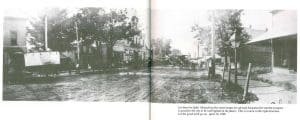The Town of Antioch
It’s First Hundred Years
1837 – 1937
By: Roberta Selter Knirsch
Published by the Trustees of the Antioch Township Library
in observance of The Town Sesquicentennial 1987
Part One.
The history of Antioch Township began on a December day in 1836. It was then that the Gage brothers, Darius and Thomas, with their friend Thomas Warner reached the banks of a winding stream just south of the Illinois-Wisconsin border. They had followed Indian trails from the Aux Plaines River, near which Warner already had staked a claim, to the Mill Creek and then to Loon Lake. There on a rise beside the Muquonago Trail and overlooking the lake, Warner decided to settle. The Gages chose a site several miles to the north where the trail forded the lively little creek that was to be named the Sequoit.
With winter fast deepening, it was necessary for the men to return to shelter farther south along the trail. In later years, they often retold the story of that hazardous journey. Overtaken by a blizzard and freezing temperatures, they were in imminent danger of death when at last they reached the safety of Willard Jones’s home fourteen miles from Warner’s claim.
The next April the Gages returned and erected a log cabin – – the first house in the town of Antioch, on the north bank of Sequoit Creek. When the cabin was built, Illinois had been a state for nineteen years.
The comparatively late date for the settlement of this area can be attributed to the reluctance of the Indians to vacate the land. It had been acquired by treaty with the Pottawatomies and other tribes at Prairie Du Chien in August of 1829, but it was not until the defeat of the Sauk leader Blackhawk in 1832 that the tribes began their exodus to beyond the Mississippi.
The Gages did not remain alone for long in their wilderness home. Reports of rich farm land at $1.25 an acre, abundant game, and plentiful water supplies combined with hard times in the Northeast to make the arduous journey seem well worth the sacrifice.
Henry S. Rector was one who made that journey. With his wife and two daughters, he arrived at the Gage cabin 1837. The newcomers stayed with the Gages until their own cabin could be built. The Rectors provided the community with its first white native on June Twenty-third, 1838 when their son Edwin was born.
